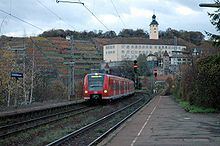Native name Neckartalbahn Stations 21 | Status Operational | |
 | ||
Termini Heidelberg Hbf.Bad Friedrichshall-Jagstfeld | ||
The Neckar Valley Railway, or Neckar Valley Main Line (German: Neckartalbahn) is a railway line from Heidelberg via Eberbach and Mosbach to Bad Friedrichshall-Jagstfeld in southwestern Germany. Today it is administered by the Verkehrsverbund Rhein-Neckar (Rhine-Neckar Transport Authority) and is partly worked by the Rhine-Neckar S-Bahn.
Contents
History
The Heidelberg–Neckargemünd section of the line was built in 1862 as part of the Baden Odenwald Railway (Baden Odenwaldbahn), running from the Heidelberg via Neckargemünd, Meckenheim, Neckarbischofsheim, Aglasterhausen, Obrigheim, Neckarelz, Mosbach, Oberschefflenz, Seckach, Osterburken, Königshofen and Lauda to Würzburg. Construction of the line was authorised by a law of 27 April 1860. The Heidelberg–Neckargemünd section was opened on 23 October 1862.
Although the most obvious option for the route between Neckargemünd and Neckarelz would have been to build the line along the Neckar, this would have meant running through Neckarsteinach and Hirschhorn, which were on the territory of the Grand Duchy of Hesse, so a hillier and longer route to the south was selected.
About ten years later, as a result of the Franco-Prussian War, the affected states became part of the German Empire, so it was agreed to build the Neckargemünd–Neckarsteinach–Eberbach–Neckarelz–Jagstfeld line, which was opened on 24 May 1879. Trains between Heidelberg and Würzburg now run over this line.
Further development until 2003
Through trains ran from Heidelberg via the Neckar Valley Railway both towards Würzburg and towards Heilbronn.
In 1955, Heidelberg Hauptbahnhof (central station) was moved from the centre of the city to its present site, which also involved a change of the route of the Neckar Valley Railway between Heidelberg Hauptbahnhof and Karlstor station (Karlstorbahnhof), near the current Heidelberg Altstadt station. Since then, the Neckar Valley Railway has been routed through the 2487 metre-long Königsstuhl tunnel that had previously been used only by freight trains to the now disused Heidelberg yard.
The Neckar Valley line was electrified the 1950s along with many other main lines of Deutsche Bundesbahn.
Until the mid-nineties, there were also long-distance passenger services on the Neckar Valley Railway, but these have since been completely abandoned.
Since 2003: opening of the Rhine-Neckar S-Bahn and future plans
Three new stations were opened with the commencement of S-Bahn operations on the Neckar Valley Railway: Heidelberg-Weststadt/Südstadt, Heidelberg-Orthopädie and Neckargemünd-Altstadt. The platform levels of the rest of the stations from Heidelberg to Neckarelz were increased to 76 centimetres to allow level access to the S-Bahn. All platforms have a length of 140 metres.
The Mosbach-Neckarelz−Bad Friedrichshall-Jagstfeld−Heilbronn section is expected to be incorporated in the long term in the network of the Heilbronn Stadtbahn.
In a few years, the Rhine-Neckar S-Bahn network is expected to be reorganised so that S-Bahn services on the Neckar Valley Railway no longer run on the Palatine Ludwig Railway to Kaiserslautern; instead they will run from Schifferstadt via Speyer to Germersheim and later to Bruchsal.
Vehicle use and station facilities
All stations of the Neckar Valley Railway served by the Rhine-Neckar S-Bahn have been rebuilt to provide barrier-free access for the disabled and equipped with protection from the weather. Some major stations (for instance, Eberbach and Neckarelz) were retrofitted with LCD destination displays a few years before the launch of S-Bahn services. Increasing the platforms to 76 cm above the running surface made possible a level entrance to the class 425.2 S-Bahn electric multiple units. The following rolling stock are used:
Passenger services
During the day services on the line run hourly on lines S1 (Homburg (Saar)–Kaiserslautern–Mannheim–Heidelberg–Osterburken) and S2 (Kaiserslautern–Mannheim–Heidelberg (on weekdays starting or ending at Eberbach or Mosbach) of the Rhine-Neckar S-Bahn and every two hours Regional-Express services operate on the Mannheim–Eberbach–Heilbronn route. The start or end of some of these RE services on Saturdays, Sundays and public holidays is at Stuttgart. While S2 services end on alternative hours in Eberbach or Mosbach, S1 services run every hour to Osterburken to give good connections to the trains on the Franconia Railway between Stuttgart and Würzburg.
Regionalbahn services run between Neckarelz and Bad Friedrichshall-Jagstfeld on the Neckarelz–Stuttgart–Ulm route each hour. These services mostly use double-deck carriages. On occasion and in the peak hours Silberling carriages are used. The double-deck carriages are hauled almost exclusively by class 146.2 electric locomotives. The Silberling carriages are hauled by Class 111 electric locomotives. All the locomotives used for Regionalbahn services on this line are based in Stuttgart.
Freight
Freight trains are mostly scheduled in the early mornings and the late evenings. These are mostly complete trains, consisting of wagons carrying cars or coal or of tank cars, operated by DB Schenker Rail Deutschland. But private transport companies also operate freight on the Neckar Valley Railway, for example, TX Logistik, Häfen und Güterverkehr Köln and BCB.
